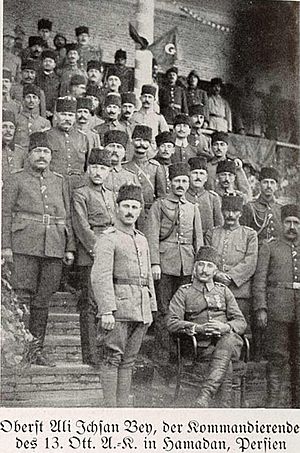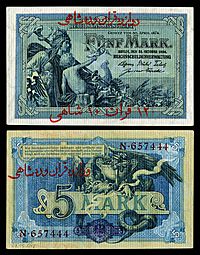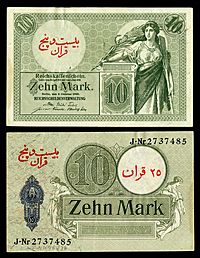Persian campaign (World War I) facts for kids
Quick facts for kids Persian campaign |
||||||||
|---|---|---|---|---|---|---|---|---|
| Part of the Middle Eastern theatre of World War I and the Russo-Turkish Wars | ||||||||
 The commander of the XIII Corps Ali İhsan Bey and his men in Hamadan |
||||||||
|
||||||||
| Belligerents | ||||||||
|
|
|
|
||||||
| Commanders and leaders | ||||||||
| Units involved | ||||||||
|
Russian Caucasus Army |
2nd Army Shekak Militants German Military Detachment |
Persian Gendarmerie |
||||||
| Strength | ||||||||
| Total: June 1916: Peak: |
Total: June 1916: |
|||||||
| Casualties and losses | ||||||||
2,474+ killed 471+ wounded |
853 killed/missing 1,676 wounded unknown captured few thousand died of disease |
2,000,000 civilian deaths (due to war related famine and disease) | ||||||
The Persian campaign, also called the invasion of Iran, was a series of battles during World War I. It took place in Persia, which was officially neutral. The main groups fighting were the Ottoman Empire, the British Empire, and the Russian Empire.
The conflict started in December 1914 and ended on October 30, 1918, when the Armistice of Mudros was signed. Local Persian groups also fought against the Ottoman and Allied forces. This war was very hard on Persia. Many people suffered due to war-related problems like famine and disease.
Persia's government, known as the Qajar government, struggled to keep the country safe and independent during and after the war. This led to a military takeover in 1921. After that, Reza Shah started a new ruling family called the Pahlavi dynasty.
Contents
Why the War Happened
Persia's Neutrality and Foreign Interests
Persia said it was neutral when World War I began. But the country quickly became involved because of the competition between the Allied Powers (like Britain and Russia) and the Central Powers (like Germany and the Ottoman Empire).
Foreign countries were interested in Persia for two main reasons. First, Persia was in a very important location. It was between British India, Russia, Afghanistan, and the Ottoman Empire. Second, oil was found in Persia in 1908. This made the country even more valuable.
The Anglo-Russian Treaty of 1907
In 1907, Britain and Russia signed a treaty. They agreed to divide Persia into three areas. Russia would control the north, near its lands. Britain would control the south, next to British India. A middle area was left as a buffer zone. This treaty was part of a long competition between Russia and Britain called the Great Game.
The treaty also helped both countries against Germany. Germany was trying to expand its influence in the region.
German and Ottoman Goals
Germany wanted to cause trouble for Britain and Russia. Before the war, Germany set up an Intelligence Bureau for the East. This group tried to encourage people in British India, Persia, and Egypt to rebel. In Persia, a German official named Wilhelm Wassmuss led these efforts. Germany hoped to free Persia from British and Russian control. They also wanted to create problems between Russia and Britain.
The Ottoman Empire, allied with Germany, had its own goals. They wanted to stop Russia from getting oil from around the Caspian Sea. The Ottoman Minister of War, Enver Pasha, believed that if Russia was defeated in Persia, the Ottomans could reach Central Asia and India. He dreamed of uniting Turkish-speaking people in a large empire.
Oil and British Interests
Before the war, the British government made a deal with the Anglo-Persian Oil Company. This company would supply oil to the Royal Navy. The British had special rights to find oil in most of Persia. This made protecting their oil interests a key goal during the war.
Who Fought in Persia
Persian Forces
Persia did not have one strong national army. Instead, different districts and tribes had their own fighting groups. These groups often had 600 to 800 soldiers. They also had some artillery. Many tribal fighters, about 50,000 in each area, were poorly armed horsemen and foot soldiers. Sometimes, these tribal leaders would even switch sides during the war.
Important tribal groups included the Qashqai, Tangistani, Laristani, and Khamseh tribesmen. The central Persian government also had a police force called the Persian Central Government Gendarmerie. This force had Swedish officers and about 6,000 troops, with 2,000 on horseback. They had modern rifles, machine guns, and mountain guns. Their job was to keep the main roads safe.
Ottoman and German Forces
In 1914, Enver Pasha of the Ottoman Empire ordered his troops to move into Persia. Their goal was to reach Dagestan and push the Russians away from the Caspian Sea.
German operations were led by Wilhelm Wassmuss. He was known as the "German Lawrence" because he dressed like a desert tribesman. He tried to convince Persian tribes to rebel against Britain.
British Forces
The British Indian Army had units in southern Persia. Their officers were experienced in fighting tribal groups. Later in the war, in 1918, a British force led by Major-General Lionel Dunsterville was formed. This group, called "Dunsterforce," had about 1,000 soldiers. They had artillery, machine guns, armored cars, and even two airplanes. Their mission was to travel through Persia to Baku and beyond.
In 1916, Britain also created the South Persia Rifles. This force was made up of local tribesmen who were paid to protect British interests.
Russian Forces
Russia had forces in Persia for a long time. The Persian Cossack Brigade was a group of Persian soldiers led by Russian officers. A small part of the Russian Caucasus Army, led by General Tovmas Nazarbekian, was also stationed there. The Cossack Brigade had about 2,000 soldiers.
Russia also brought in a group of Armenian volunteer units led by Andranik Ozanian to the region.
- Forces engaged at the Campaign
-
Dunsterville with the staff of Dunsterforce
-
Assyrian General Agha Petros saluting his men after capturing turkish soldiers and their banner
Key Battle Areas
Most of the fighting happened in northern Iranian Azerbaijan. This area includes cities like Tabriz, Urmia, and Khoy.
Main Events of the Campaign
Before the Fighting Started
Before the war, the Persian government struggled to keep order. Different tribes often raided areas. Russia had troops in northern Persia, saying they were there to protect Armenian and Assyrian Christians. They occupied cities like Tabriz and Urmia.
World War I began in July 1914. Even before Russia and the Ottoman Empire started fighting, the border areas became unsafe. The Russians closed Ottoman offices in some cities and gave weapons to some Armenian and Assyrian Christians. The first major battles between Russia and the Ottomans began in November 1914.
1914: Early Moves
In December 1914, Russia pulled some troops out of Persia because of a big battle elsewhere. Only a small group of Russian and Armenian volunteer soldiers remained. The Ottoman Empire sent troops into Persia. On December 14, Ottoman forces took the city of Qotur and moved towards Khoy. However, many Ottoman troops were needed for other battles, so their advance into Persia slowed down.
1915: German Influence and Ottoman Attacks
In 1915, the German agent Wilhelm Wassmuss tried to start a rebellion in Persia. He was briefly arrested but escaped. He hoped to work with pro-German Persians and an Ottoman attack.
In January 1915, Ottoman forces captured Urmia and Tabriz. The Russians were surprised but quickly sent more troops. By January 30, the Russians had recaptured Tabriz.
In April 1915, Ottoman forces under Halil Bey tried to take Dilmaghan. This led to fierce fighting with Armenian volunteers led by Andranik Ozanian. The Armenians held their ground until Russian troops arrived, forcing Halil Bey to retreat. Halil Bey lost many soldiers and was ordered to leave Persia to help in other areas.
Later in 1915, Russian forces had to retreat in the Caucasus. This also caused some Russian troops in Persia to pull back. In August, British forces occupied Bushire in southern Persia.
In November 1915, Persian Gendarmerie (police) forces, who supported the Central Powers, fought against pro-Russian groups. They captured cities like Shiraz, Yazd, and Kerman. However, Russian forces advanced on Tehran. On November 10, Russian troops took Hamadan. By the end of November, the Russian Caucasus Army and Armenian volunteers had taken Tehran.
In December 1915, the Shah of Persia appointed a new government that supported the Allies. Russian forces continued to advance, taking Hamadan without much resistance. Around this time, Sir Percy Sykes began forming the South Persia Rifles to protect British interests.
1916: Shifting Control
In January 1916, Russian forces under General Nikolai Baratov pushed back Ottoman and Persian tribal groups, occupying Hamadan. They continued to capture Kermanshah and Kharind. By May, Baratov's troops were close to Baghdad.
In February 1916, the Russians defeated the Persian Gendarmerie, who retreated. Many gendarmes then went into exile.
In May 1916, the Ottomans launched a second invasion of Persia with about 25,000 troops. On June 3, the Russians attacked but were pushed back. The Ottomans then crossed back into Persia.
In late May, Ottoman forces under Colonel Ali İhsan Bey advanced against Baratov. Baratov hoped to capture Baghdad, but the Ottomans pushed his forces back. Ali İhsan Bey captured Kermanshah on July 2 and Hamadan on August 10. Baratov had to retreat north. The gendarmes returned to Kermanshah in August.
|
|
|
|
|
(5 and 10 Mark, 1904/06) with red Persian denomination overstamp for 12 qiran 10 shahi and 25 qiran respectively (1916–17). Part of the toman issue by World War I German forces in Iran. |
In June 1916, British forces under Percy Sykes reached Kerman in southern Persia. They supported Russian operations until June 1917.
In December 1916, Baratov's Russian forces moved on Qoms and Hamadan, taking both cities that month.
1917: Russian Revolution and Ottoman Advance
In 1917, the Russian Revolution caused chaos and stopped all Russian military actions. Russian troops began to leave Persia. By November, many Russian soldiers had deserted.
On December 16, the Armistice of Erzincan was signed. This officially ended fighting between the Ottoman Empire and Russia. However, the Ottomans still sent a new army into Persia. Their goal was to stop the British advance and control the area between Lake Urmia and the Caspian Sea.
The Russian collapse left the Armenian population in Van province without support from the Allies. They prepared to defend themselves.
1918: British and Ottoman Clashes
In 1918, the British encouraged the Armenians to keep fighting. British officers helped organize them under the command of Lionel Dunsterville in Baghdad. This "Dunsterforce" aimed to reach the Caucasus through Persia. Once there, they hoped to gather an army of Armenians and other pro-Ally groups.

On March 3, 1918, the Ottoman Empire signed the Treaty of Brest-Litovsk with Russia. This treaty returned the borders to how they were before the war. It also gave some cities to the Ottoman Empire.
In April 1918, Armenians from Van province moved eastward into Iranian Azerbaijan. The Ottoman Third Army attacked. The retreating Armenians and Assyrians tried to hold their ground near Dilman but continued to move south.
On June 8, 1918, Ottoman forces entered Tabriz. They fought Armenian volunteer groups. The Ottomans captured Dilman on June 18 and Urmia on July 31. By the end of July, more British troops arrived in Persia, and the Ottoman advance stopped.
During July 1918, the British Army took control of most of Mesopotamia and large parts of Iranian Azerbaijan. They set up a camp for Assyrian and Armenian refugees in Iraq.
By September 1918, the Ottomans controlled northern Persia, between Tabriz and the Caspian Sea. But they lost the rest of the region to the British. The Ottomans held this territory until October 30, 1918, when they signed the Armistice of Mudros. This agreement ended all military operations.
What Happened After the War
After the Ottoman Empire lost World War I, its lands were divided. The Ottoman goal of pushing Russia out of the region failed. In 1920, Russian and Bakhtiari troops landed in Persia, forcing the pro-Turkish parliament to break up.
The immediate result of the Persian Campaign was the Anglo-Persian Agreement. This agreement gave the Anglo-Persian Oil Company rights to drill for oil in Persia. The British government also tried to make Persia a "protectorate," meaning Britain would control its foreign affairs and defense. This was to secure their access to Persia's oil.
In late 1920, a Soviet Socialist Republic in Rasht planned to march on Tehran. But Soviet forces left in 1921. This helped Britain's goal of controlling Persia. In that year, a military takeover happened. Reza Khan, a Persian officer, became the new leader. He later became the Shah and started the Pahlavi dynasty. Britain supported this takeover because they wanted to stop Soviet influence in Iran, which could threaten British India.
See also
- Anglo-Soviet Invasion of Iran
- Armenian genocide
- Assyrian genocide
- Caucasus campaign
- Military history of Iran
- Persian famine of 1917-1918
- Russo-Persian Wars
- Turko-Persian War
Images for kids
-
German Imperial Treasury notes (5 Mark, 1904/06) with red Persian denomination overstamp for 12 qiran 10 shahi (1916–17). Part of the toman issue by World War I German forces in Iran.
-
German Imperial Treasury notes (10 Mark, 1904/06) with red Persian denomination overstamp for 25 qiran (1916–17). Part of the toman issue by World War I German forces in Iran.
References
- Bruinessen, Martin. "A Kurdish warlord on the Turkish-Persian frontier in the early Twentieth century: Isma'il Aqa Simko". In Atabaki (2006). Harvc error: no target: CITEREFAtabaki2006 (help)
- Edward J. Erickson. "Ordered to Die: A History of the Ottoman Army in the First World War". Greenwood Publishing Group, 2001.
- Atabaki, Touraj (ed.) (2006). Iran and the First World War: Battleground of the Great Powers. New York: I.B.Tauris. ISBN: 1-86064-964-5, ISBN: 978-1-86064-964-6.
- Bati, Alum. 1918: Azerbaijan At War – a two-part article on Azerbaijan and Dunsterforce in 1918, for Part 1 see http://www.visions.az/en/news/661/cc10060a/; for Part 2 see http://www.visions.az/en/news/686/ecbd8399/
- A.J. Barker, The Neglected War: Mesopotamia, 1914–1918 (Faber and Faber, 1967)
- Paul Knight: The British Army in Mesopotamia, 1914–1918 (McFarland, 2013, ISBN: 978-0786470495)











